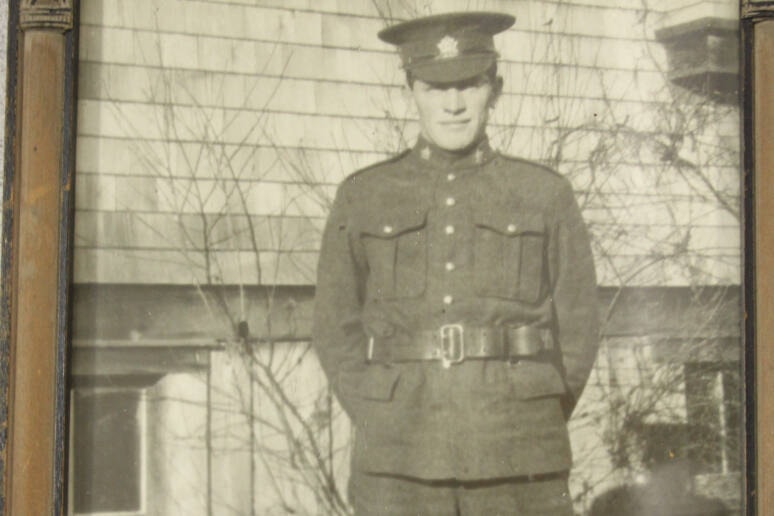By T.W. Paterson
We know his name: F.R.V. Nello. We know that he was a Warrant Officer, Class 1, in the Royal Canadian Air Force.
We know that, in October 1946, he was posthumously awarded his “Operational Wings…in recognition of gallant service in action against the enemy.”
What we don’t know is why WO Nello’s citation turned up, for sale, at a Ladysmith antique sale. Personally signed by Air Marshal and Chief of Staff Robert Leckie, the citation — priceless, one should think, to his family — is neatly framed. Glued to its back is a letter typed on official RCAF stationery and addressed to his mother, Mrs. Jesse Nello, Vancouver:
“It is a privilege to have the opportunity of sending you the Operational Wings and Certificate in recognition of the gallant services rendered by your son… ” Wing Commander W. A. Dickey wrote. “I realize there is little which may be said or done to lessen your sorrow, but it is my hope that these ‘Wings’, indicative of operations against the enemy, will be a treasured memento of a young life offered on the altar of freedom and defence of his Home and Country.”
Frank Richmond Vincent Nello, of Westview B.C., was serving with the Royal Air Force as a navigator of a Halifax bomber. His final mission, with 462 Australia Squadron, was on Oct. 12, 1943, when his our aircraft was shot down over Rhodes, Greece.
His name is on North Africa’s Alamein War memorial. Frank Nello was 27.
No serious antique buff will be surprised by the discovery of WO Nello’s citation at an antique or garage sale, or its subsequent purchase by a collector of war memorabilia. Obviously, families, too, die, and priceless personal mementos enter the public domain via estate sales. There, collectors eagerly await them.
But it’s somewhat ironic, even sad, that these medals and citations, so hard won, and within living memory, should adorn the walls of strangers.
Is this wrong? One could argue against the morality of buying and selling these treasures. Yet, is this not a form of immortality, a form of remembrance?
Hanging on this writer’s bedroom wall is a belt buckle which has been converted to a woman’s broach. Found — rescued — at a Duncan flea market, it belonged to Lieut. Kenneth L Keith, DSC, MID, Royal Navy Fleet Air Arm. DFC stands for Distinguished Service Cross, MID means Mentioned In Dispatches.
Lieut. Keith went overseas from Calgary in 1935 and served for three years in the RAF before being transferring to the RNFAA. Upon the outbreak of war, he served in the Mediterranean aboard the aircraft carrier HMS Eagle. For “shooting down Italian bombers,” he earned his MID. He also participated in the attack on the Italian Fleet at Taranto and survived the torpedoing of the Eagle.
His DSC was won during the invasion of Crete for “placing an anti-aircraft gun in position to destroy landing German paratroops. [He] afterwards took charge of a mixed force of 100 men and led them safely to the main line… Although in ill health at the time, Lieut. Keith carried out this operation with zeal and cheerfulness.”
Only two weeks later, while commanding a squadron of fighter planes providing air cover for a destroyer fleet off Tobruk, he was shot down. Rescued from the sea by the Germans, he was taken to hospital at Derna. It was there that he died of his wounds.
I never met Lieut. Keith. I know no more about him than I have written here. But I ‘remember him’ every time I see his buckle, matted and framed, on my wall.
At a Shawnigan Lake garage sale some years ago, a box of picture frames finally attracted a buyer. They were out-of-the-ordinary only because they contained their original photographs. Oh, the people in the portraits might be of a Mill Bay family, the seller volunteered, but she wasn’t sure.
The elderly couple sit in front of a shingle-clad house, in the shade of young apple trees. An attractive young woman smiles shyly. The young man in the First World War army uniform stares into the camera. Tall, sturdy, with legs like pilings, he obviously is hardened by physical labour. The old folks will be his parents, the young woman a sister or girlfriend. The fruit trees are those of their Mill Bay Farm? It’s a good guess, anyway.
The garage sale hunter wants only the frames and willingly parts with the photos. Years later, Cobble Hill farmer and local historian Bob Dougan identifies him: the handsome soldier is Private Thomas James Thompson Jeffrey, son of Mr. and Mrs. William Jeffrey, Cameron-Taggart Road. He was serving with the 72nd Battalion, Seaforth Highlanders, CEF when killed in action — six weeks before Armistice Day.
His photograph, and those of his family, are in good hands.
T.W. Paterson is an author and historian. For more, check out twpaterson.com
